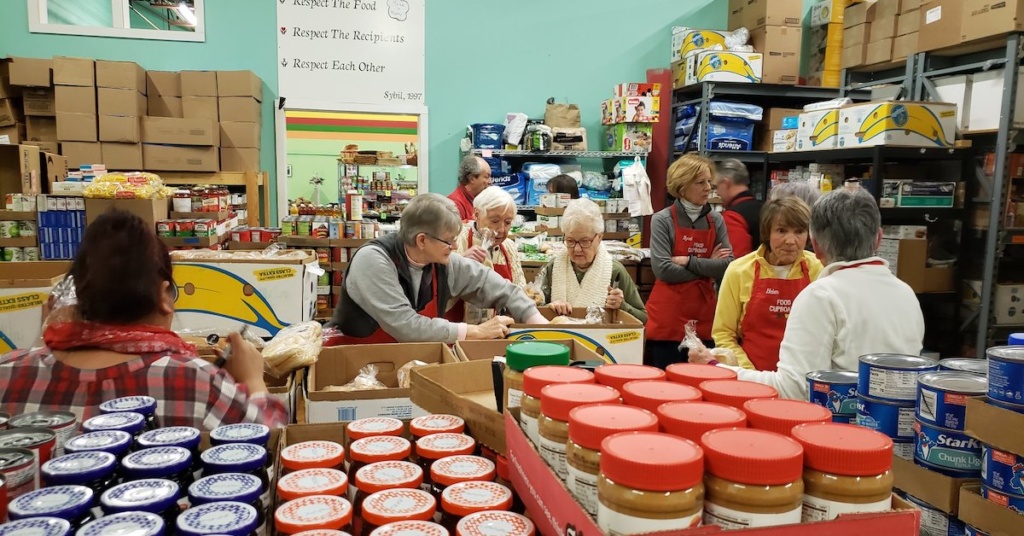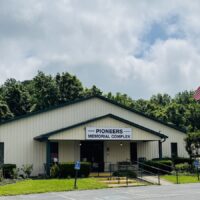In the towns of Augusta and Manchester, Maine, residents facing food insecurity can walk through their local food bank like they’re walking through a supermarket.
At the Good Shepherd Food Bank, participants can select meat, dairy, produce, and other foods from the food bank just like they’re shopping, but never face a cashier or check-out line. The food bank fully reopened July 12, officials said, just as need in the area started to increase. During the pandemic, the food bank was open, only with fewer items.
- RELATED: Aaron McNeil’s efforts nearly double as more local families face hunger
- RELATED: Pandemic could make food insecurity worse among older adults in region
Augusta, Maine, has a population of just over 18,000 people – Manchester, 2,580. But Bob Moore, head of the food bank, said its distributions are rising – up 20% from last year. It’s a number he expects to continue to rise.

Officials expect food insecurity in Kennebec County will increase to 14% of the county’s population – 17,030 residents – because of the Covid-19 pandemic.
Nationally, one in six people, about 17.6%, face food insecurity, said Geri Henchy, Director of Nutrition Policy and Early Childhood Programs with the Food Research & Action Center (FRAC) in Washington, D. C.
“It’s unacceptably high,” Henchy said. “It’s lower than it was at its peak during the pandemic, but it’s still high. And it’s not returning toward normal soon.”
Henchy said food insufficiency, which measures how many people do not have access to enough food, affected one in 10 Americans this year.
Data showed that 9.7% of American households reported having food insufficiency between June 9 and June 21, 2021. In households with children, 13% reported food insufficiency. A reported 18.3% of Black households and 16% of Latinx households reported food insufficiency during the same time period.
While FRAC’s latest study did not specifically address rural areas, Henchy said she expected it to mirror previous studies that showed higher rates of food insecurity in rural areas, like the rural South.
A FRAC study released in July 2020, found that the Southern region of the United States had higher food insecurity rates (12.6%) than the rest of the country (11.4%).
Part of the math of food insecurity will change because of the permanent increase in SNAP benefits that passed last week and will go into effect on October 1, 2021. The Biden administration raised the benefit on average by $36.24 per person, per month, or $1.19 per day
“Many individuals in the Southern Region of the country live with the crushing burdens of food insecurity, poverty, and limited opportunities, and the public health and economic fallout of Covid-19 are only making matters worse,” said Luis Guardia, president of FRAC.
In the towns of Augusta and Manchester, Maine, residents facing food insecurity can walk through their local food bank like they’re walking through a supermarket.
At the Good Shepherd Food Bank, participants can select meat, dairy, produce, and other foods from the food bank just like they’re shopping, but never face a cashier or check-out line. The food bank fully reopened July 12, officials said, just as need in the area started to increase. During the pandemic, the food bank was open, only with fewer items.
Augusta, Maine, has a population of just over 18,000 people – Manchester, 2,580. But Bob Moore, head of the food bank, said its distributions are rising – up 20% from last year. It’s a number he expects to continue to rise.
Officials expect food insecurity in Kennebec County will increase to 14% of the county’s population – 17,030 residents – because of the Covid-19 pandemic.
Nationally, one in six people, about 17.6%, face food insecurity, said Geri Henchy, Director of Nutrition Policy and Early Childhood Programs with the Food Research & Action Center (FRAC) in Washington, D. C.
“It’s unacceptably high,” Henchy said. “It’s lower than it was at its peak during the pandemic, but it’s still high. And it’s not returning toward normal soon.”
Henchy said food insufficiency, which measures how many people do not have access to enough food, affected one in 10 Americans this year.
Data showed that 9.7% of American households reported having food insufficiency between June 9 and June 21, 2021. In households with children, 13% reported food insufficiency. A reported 18.3% of Black households and 16% of Latinx households reported food insufficiency during the same time period.
While FRAC’s latest study did not specifically address rural areas, Henchy said she expected it to mirror previous studies that showed higher rates of food insecurity in rural areas, like the rural South.
A FRAC study released in July 2020, found that the Southern region of the United States had higher food insecurity rates (12.6%) than the rest of the country (11.4%).
Part of the math of food insecurity will change because of the permanent increase in SNAP benefits that passed last week and will go into effect on October 1, 2021. The Biden administration raised the benefit on average by $36.24 per person, per month, or $1.19 per day
“Many individuals in the Southern Region of the country live with the crushing burdens of food insecurity, poverty, and limited opportunities, and the public health and economic fallout of Covid-19 are only making matters worse,” said Luis Guardia, president of FRAC.
“People who experience food insecurity often need to make difficult decisions like choosing between food and medicine or food and rent. When people have a hard time putting food on the table, it not only harms them, it has costly implications on our nation’s economy and health system.”
Mike Halligan, CEO of God’s Pantry in Lexington, Kentucky, said that despite a greater need for services, many food banks are seeing fewer people.
“Many people who are truly hungry, who are food insecure, are benefiting from two key programs that are being offered by the federal government,” he said. “One is the stimulus checks and the other is increased SNAP benefits. So we are actually, even though the need is up, we are actually seeing less people right now reaching out for emergency food, assistance, through a food bank or a food bank because they have available to them benefits related to the pandemic.”
But, he said, he expects food insecurity to rise as federal benefits like federal unemployment assistance and eviction moratoriums end.
“Those (benefits) go through the end of September. All of those benefits are helping address hunger and they’re allowing folks to get food from a grocery store rather than having to go to a food bank or a food pantry,” he said.
“But the fundamental issue of food insecurity does not go away. It does not change. Where people will then access food is what will change and we expect to see more individuals accessing food through emergency food assistance programs, like those that are offered at God’s Pantry Food Bank when those federally funded benefits go away later this year.”
In rural areas of the state, Halligan said, school programs helped families feed children during the school year. Those have changed to help families, but they would likely change again when the federal benefits end.
“[The Summer EBT card program] is providing funding for families to go buy groceries to feed their children in the summer when they might otherwise be going to a summer feeding program or some kind of after school feeding program,” he said. “So it’s making it easier for households with kids in rural America and rural Kentucky to get food through a grocery store. But with that incremental benefit, again, that’s one that expires at the end of September, we expect to see some differences in the fall versus what we’re seeing right now.”
In Kentucky, he said, four of the 10 most food insecure counties in the United States are in Eastern Kentucky. Of the 50 most food insecure counties in the United States, 14 are in Central and Eastern Kentucky. Most of them, Halligan said, are rural. The biggest reason for the food insecurity in those areas is lack of access to food – not just in how far away from food residents in those counties live, but in access to affordable food.
Halligan said he hopes lawmakers see that now, especially in rural areas, it’s no longer a matter of providing food and hoping people show up, but now more a matter of getting food to the people, as in providing them with cards that help them buy food on their own.
“The average household that needs food assistance needs it three times a year for three to four months, and it’s cyclical,” he said. “We need to ask ourselves how can we improve access to food in a country with such abundance? How can we ensure that anyone across the United States has access to food and has ways of accessing it that is cost-effective?”






